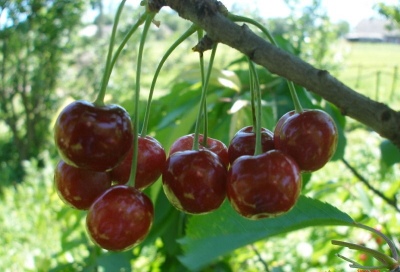
- Authors: A.I. Astakhov, M.V. Kanshina (V.R. Williams All-Russian Research Institute of Feed)
- Year of approval: 2009
- Barrel type: wood
- Growth type: medium-sized
- Crown: rounded-oval, raised, of medium density
- Escapes: medium, straight, gray-olive, naked, vertical
- Leaves: medium, oval, green, sharply pointed, curved upwards
- Fruit size: average
- Fruit shape: flat-round
- Fruit color: light red
Despite the emergence of new varieties of fruit trees, old varieties of cherries are still in demand among amateur gardeners and professionals. Spanka is a time-tested cherry variety, distinguished by both early fruiting and excellent productivity, as well as having many varieties. So, Shpanka Bryanskaya is a relatively new offshoot of it.
Breeding history
Spanka is considered a folk variety, because there is no exact data on who its author was when it arose. Presumably, the culture appeared at the turn of the XIX-XX centuries. (but there is evidence that about 2 centuries ago) through natural cross-pollination of cherries and cherries. There is no data from which varieties the hybrid was obtained, but there is a hypothesis that the selection occurred as a result of a natural mutation.
Initially, the culture appeared in the vastness of Ukraine, but later quickly began to spread to neighboring territories: Moldova and the southern outskirts of Russia. Today, a name such as Shpanka includes many varieties that have spread in different regions and countries. The variety has been successfully zoned for the Moscow region and the Volga region. Some varieties of Shpanki grow well even in Siberia and the Urals.
Breeding work continues to improve the characteristics of the folk hybrid, as a result of which such separate varieties of Shpanki as Dwarf, Rannyaya, Shimskaya, Large-fruited, Donetsk, Bryansk were obtained.
Shpanka Bryanskaya is the youngest variety. It appeared thanks to the efforts of domestic breeders A.I. Astakhov, M.V. Kanshina. The work was carried out on the basis of the V.R. Williams All-Russian Research Institute of Feed. The admission application was submitted in 2006. And already in 2009, the variety was included in the lists of the State Register for the Russian Federation and zoned for the Central Region.
Description of the variety
The medium-sized tree of Shpanki Bryanskaya is 4 m high. The crown is compact, not very dense, rounded-oval. The color of the shoots is gray-olive, they grow vertically, there is no pubescence. Leaves are oval in shape, their color is green. The leaf blades are curved upward, sharply pointed, with double serrate edges. The lifespan of a tree of this variety is a quarter of a century.
Fruit characteristics
The fruits of Shpanki Bryanskaya are small, only 4 g. The shape is flat-round. The berries are colored with a light shade of red, the pulp is creamy, the juice is transparent pink. Cherries are attached to thickened stalks. Medium-sized bone from the pulp leaves easily.
Taste qualities
Berries Shpanki Bryanskaya sweet and sour, tasting score 3.7 points. The fruits, although considered universal, are best suited for canning. Fruit composition:
- dry matter - 12.9%;
- sugar - 8.7%;
- acids - 1.1%;
- vitamin C - 13.1 mg /%.
Ripening and fruiting
The fruits of the described cherry variety ripen early. She begins to bear fruit for 3-4 years.

Yield
The productivity of the crop is on average 73 centners per hectare. And 1 tree can bring about 30 kg of cherries.
Self-fertility and the need for pollinators
Shpanka Bryanskaya does not require cross-pollination with other trees, as it is self-fertile. Even a single growing tree will bear fruit. However, when the crop is grown in the company of different cherry trees, the harvest is more abundant.
Landing
In warm climates, cherry planting can be carried out in the fall, about 1 month before the first frost. As a rule, this is the end of September or the beginning of October. In the Central region and to the north, where the climate is colder, it is better to plant a tree in spring, so it will have time to get stronger and take root before the winter period.


Growing and care
The agricultural technology of the described culture is quite simple, as for all cherries. It contains activities such as feeding, crown formation, prevention and control of ailments and insect pests. The main thing is that in especially frosty winters the soil under the trunk is covered with snow. If there is no snow, you will need to cover the soil around the trunk with 10-centimeter mulch, which can be used as sawdust, dead leaves, and more. It is important for the plant that the root system does not freeze.


Disease and pest resistance
Shpanka Bryanskaya is resistant to all fungal diseases. May be affected by coccomycosis.
































































